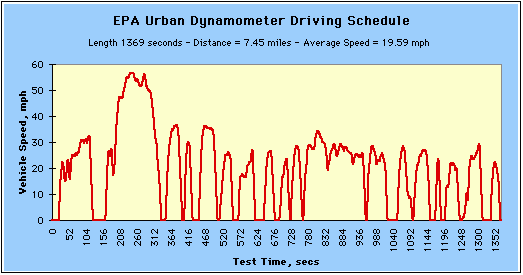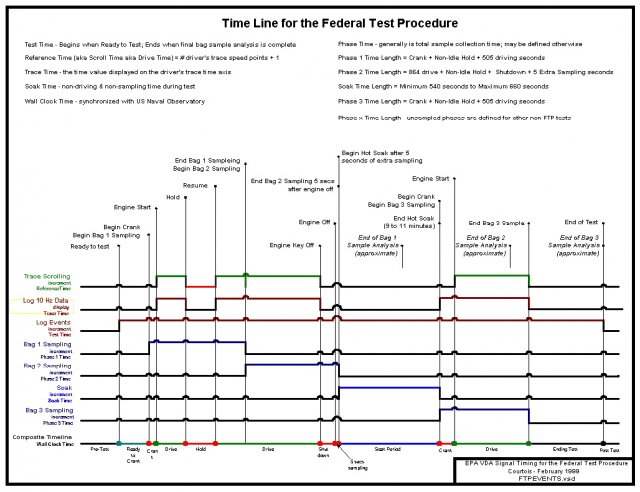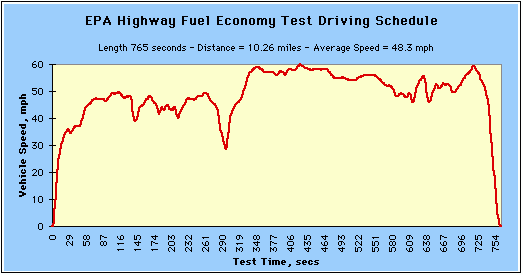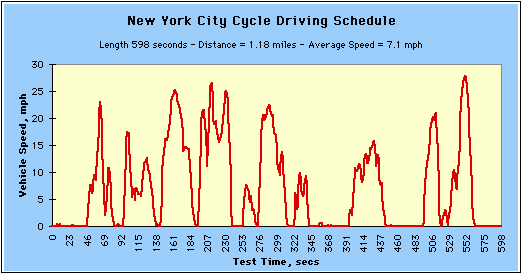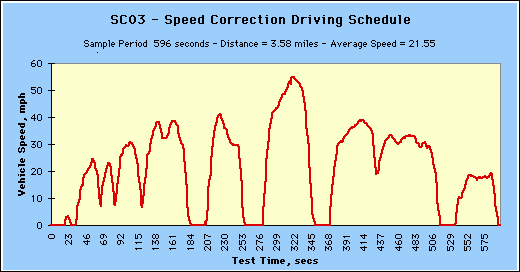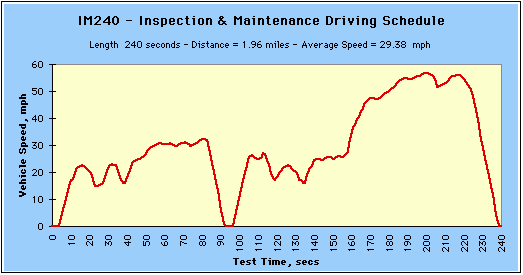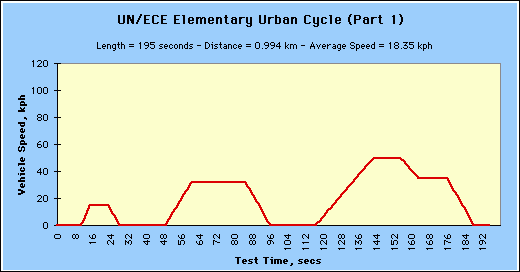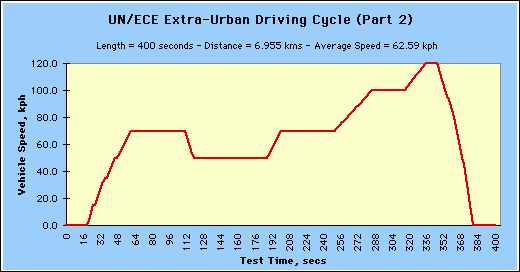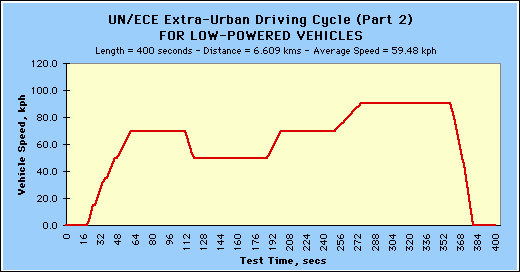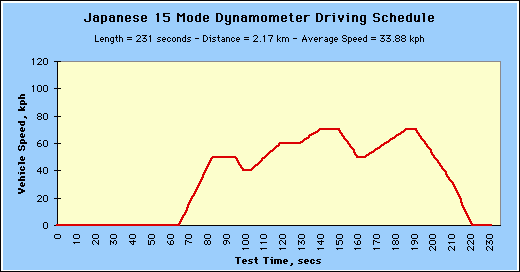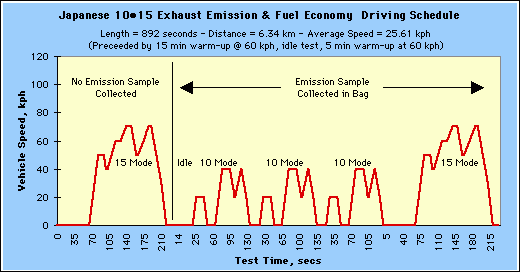Dynamometer Drive Schedules
- EPA Vehicle Chassis Dynamometer Driving Schedules
- California EPA Air Resources Board Dynamometer Driving Schedules
- Economic Commission for Europe Dynamometer Operating Cycles
- Driving schedules specified in Japanese Technical Standards
- Vehicle Chassis Dynamometer Shift Schedule Formatting Guidance
This page provides the chassis dynamometer driving schedules and shift schedules used by EPA for vehicle emissions and fuel economy testing. This page also provides detailed information on those drive schedules in addition to technical information on drive schedules used by states, Europe, and Japan for reference.
The Code of Federal Regulations is the official source of EPA’s vehicle/engine certification test procedures.
Graphic Review of Driving Schedules
| EPA Vehicle Chassis Dynamometer Driving Schedules (DDS) - files contain tab delimited ASCII columns | |
|---|---|
The EPA Urban Dynamometer Driving Schedule (UDDS) is commonly called the "LA4" or "the city test" and represents city driving conditions. It is used for light duty vehicle testing. The UN/ECE Regulation 53 refers to the EPA UDDS as the "Test Equivalent to the Type 1 Test (verifying emissions after a cold start)." |
|
The Federal Test Procedure (FTP) is composed of the UDDS followed by a 10-minute soak and then a repeat of the first 505 seconds of the UDDS. It is often called the EPA75. The dynamometer portion of the test procedure has a very complex timeline of events. |
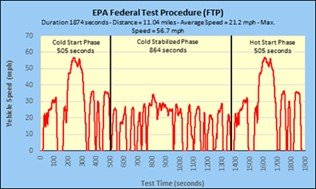
|
The Highway Fuel Economy Driving Schedule (HWFET) represents highway driving conditions under 60 mph. |
|
The New York City Cycle features low speed stop-and-go traffic conditions.
|
|
The US06 is a high acceleration aggressive driving schedule. |
|
|
| |
The LA-92 is for Class 3 Heavy-Duty vehicles that are subject to Tier 3 standards. The first 1,435 seconds are the Hot LA-92 driving schedule. |
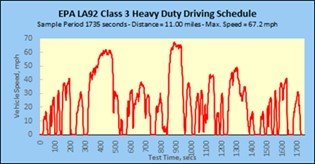
|
While Class II and III Highway Motorcycles (at or above 170 cc) still follow the standard FTP, Class I-B Motorcycles (50 to < 170 cc) follow this reduced-speed Motorcycle FTP. It is equivalent to the standard FTP except from 164 to 332 seconds, and again from 1533 to 1701 seconds. It is represented here in kilometers per hour (kph). Note that there is a 10-minute soak before repeating the first 505 seconds of the UDDS. |
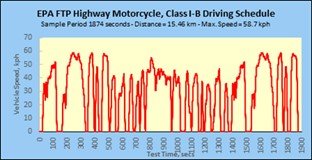
|
Vehicle Chassis Dynamometer Shift Schedule Formatting Guidance
- Graphics images and one hertz text files for the driver's traces for the FTP, HWFET and other drive schedules are available on this page.
- 10 Hertz Text Files for some of traces are also available on this page.
- Sample Formatting Tool (xls) for putting shift schedule data into the CFEIS shift schedule format.
- Draft Guidance for submission of shift schedules to the NVFEL (txt) .
- Example EPA 5 speed FTP, HWFET and US06 shift schedules are in the following files.
| State Program Dynamometer Driving Schedules | |
|---|---|
The California Air Resources Board uses the Hot LA-92, i.e. the first 1,435 seconds of the LA-92 Dynamometer Driving Schedule shown above as an emission inventory improvement tool. Compared to the FTP, the LA-92 has a higher top speed, a higher average speed, less idle time, fewer stops per mile, and a higher maximum rate of acceleration. | |
The LA-92 Short contains just the first 969 seconds of the LA-92 Dynamometer Driving Schedule. | |
While no longer required for EPA certification, the IM240 may be useful for Inspection and Maintenance programs. |
|
Economic Commission for Europe Dynamometer Operating Cycles - Official guidance is found in the United Nations Economic Commission for Europe (UN/ECE) WP.29 1958 Agreement and its Addenda. Guidance is specifically found in Regulation 83 of the Regulations for the Construction of Vehicles.
| Economic Commission for Europe Dynamometer Operating Cycles | |
|---|---|
The UN/ECE Elementary Urban Cycle is Part 1 of the ECE Type 1 Test. |
|
The UN/ECE Extra-Urban Driving Cycle is Part 2 of the ECE Type 1 Test. |
|
The UN/ECE Extra-Urban Driving Cycle (Low Powered Vehicles) is an alternative for Low-Powered Vehicles for Part 2 of the ECE Type 1 Test. |
|
Driving schedules specified in Japanese Technical Standards - Official guidance is found in the Japanese Industrial Safety and Health Association (JISHA) Technical Standards. The 11 Mode and 13 Mode driving schedules are not yet available for posting. Technical Guidance Include:
- Rev. 11-4-28 Technical Standard for 10¥15-Mode Exhaust Emission Measurement for Gasoline-Fueled Motor Vehicles (Jisha 899, 1983);
- Rev. 11-4-29 Technical Standard for 10-Mode and 11-Mode Exhaust Emission Measurement for Gasoline-Fueled Motor Vehicles (Jisha 899, 1983);
- Rev. 11-4-30 Technical Standard for 13-Mode Exhaust Emission Measurement for Gasoline-Fueled Motor Vehicles (Jisha 899, 1983);
- Rev. 11-4-31 Technical Standard for 10.15-Mode Exhaust Emission Measurement for Diesel-Powered Motor Vehicles (Jisha 899, 1983);
- Rev. 11-4-32 Technical Standard for 10-Mode Exhaust Emission Measurement for Diesel-Powered Motor Vehicles (Jisha 899, 1983);
- Rev. TRIAS 5-2-1990 10-Mode Fuel Economy Test Procedure for Gasoline-Fueled Motor Vehicles; and
- Rev. TRIAS 5-3-1991 Technical Standard for 10.15- Fuel Economy Test Procedure for Gasoline-Fueled Motor Vehicles.
| Driving schedules specified in Japanese Technical Standards | |
|---|---|
The Japanese 10 Mode Cycle is used as a component of the total driving schedule for the 10.15 Mode Exhaust Measurement and Fuel Economy Test Procedures. |
|
The Japanese 15 Mode Cycle is used as a component of the total driving schedule for the 10.15 Mode Exhaust Measurement and Fuel Economy Test Procedures. |
|
The Japanese 10.15 Mode Driving Schedule for Exhaust Measurement and Fuel Economy Test Procedures are specified in Jisha Technical Standards (Jisha 899, 1983). |
|

